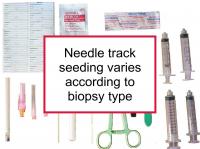Although of small likelihood, core needle biopsies have the disadvantage that needle tract seeding may occur and affect subsequent local recurrence and overall survival rates of patients who go on to receive lumpectomies. Now a new study has demonstrated that a vacuum-assisted device is less likely to result in breast cancer seeding.
Biopsies of 148 breast cancers performed using ultrasonographically guided core needle biopsies with a needle gun were compared with 105 breast cancers biopsies performed using a vacuum suction probe. Cytological results derived from the needle wash material were used to estimate the potential risk of needle tract breast cancer seeding.
Less than half the percentage of positive cytological findings were observed using the directional vacuum-assisted device (33%) than the automated core needle gun (69%). The authors conclude that the use of the directional vacuum-assisted device significantly lowers the potential risk of needle tract seeding of breast cancer after ultrasonographically guided needle biopsy.
Seeding is known to occur along pathways created by biopsies
The potential for tumor seeding along the needle path has long been a concern regarding breast cancer biopsies. In fact, evidence exists to suggest that such seeding can and does occur up to half of the time. However, studies that have examined the question as to whether such seeding has an impact on survival generally have been reassuring. Apparently, most cancer cells dispersed in such a manner do not survive.
Nevertheless, cases have been described in which local recurrences were found in the biopsy path. The question is, what can be done to minimize the possibility of a breast cancer recurrence resulting from such tumor seeding?
Strategies to minimize impact of any tumor seeding
Radiation treatment appears to be an effective method for destroying any breast cancer cells dispersed in the breast by needle biopsies. However, the needle tract must be part of the radiation field.
It is also preferable that any subsequent lumpectomy (or more extensive breast conserving surgery) remove all of the tissue immediately surrounding the biopsy path, if possible. These are simple precautions that normally would not add anything to the cost or difficulty of the procedures. Women who have core needle biopsies should consider keeping track of the location of the entrance point of the needle (or needles) and discussing the matter with their surgeons and radiologists.
